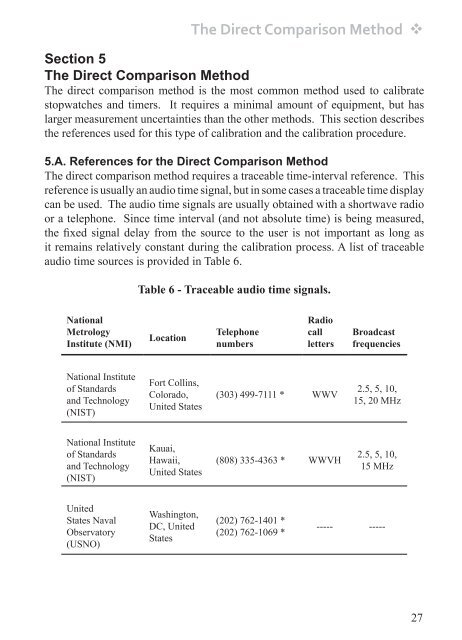Stopwatch and Timer Calibrations - National Institute of Standards ...
Stopwatch and Timer Calibrations - National Institute of Standards ...
Stopwatch and Timer Calibrations - National Institute of Standards ...
- No tags were found...
You also want an ePaper? Increase the reach of your titles
YUMPU automatically turns print PDFs into web optimized ePapers that Google loves.
The Direct Comparison Method <br />
Section 5<br />
The Direct Comparison Method<br />
The direct comparison method is the most common method used to calibrate<br />
stopwatches <strong>and</strong> timers. It requires a minimal amount <strong>of</strong> equipment, but has<br />
larger measurement uncertainties than the other methods. This section describes<br />
the references used for this type <strong>of</strong> calibration <strong>and</strong> the calibration procedure.<br />
5.A. References for the Direct Comparison Method<br />
The direct comparison method requires a traceable time-interval reference. This<br />
reference is usually an audio time signal, but in some cases a traceable time display<br />
can be used. The audio time signals are usually obtained with a shortwave radio<br />
or a telephone. Since time interval (<strong>and</strong> not absolute time) is being measured,<br />
the fixed signal delay from the source to the user is not important as long as<br />
it remains relatively constant during the calibration process. A list <strong>of</strong> traceable<br />
audio time sources is provided in Table 6.<br />
Table 6 - Traceable audio time signals.<br />
<strong>National</strong><br />
Metrology<br />
<strong>Institute</strong> (NMI)<br />
Location<br />
Telephone<br />
numbers<br />
Radio<br />
call<br />
letters<br />
Broadcast<br />
frequencies<br />
<strong>National</strong> <strong>Institute</strong><br />
<strong>of</strong> St<strong>and</strong>ards<br />
<strong>and</strong> Technology<br />
(NIST)<br />
Fort Collins,<br />
Colorado,<br />
United States<br />
(303) 499-7111 * WWV<br />
2.5, 5, 10,<br />
15, 20 MHz<br />
<strong>National</strong> <strong>Institute</strong><br />
<strong>of</strong> St<strong>and</strong>ards<br />
<strong>and</strong> Technology<br />
(NIST)<br />
Kauai,<br />
Hawaii,<br />
United States<br />
(808) 335-4363 * WWVH<br />
2.5, 5, 10,<br />
15 MHz<br />
United<br />
States Naval<br />
Observatory<br />
(USNO)<br />
Washington,<br />
DC, United<br />
States<br />
(202) 762-1401 *<br />
(202) 762-1069 *<br />
----- -----<br />
27
















